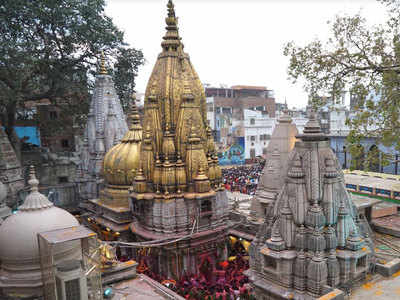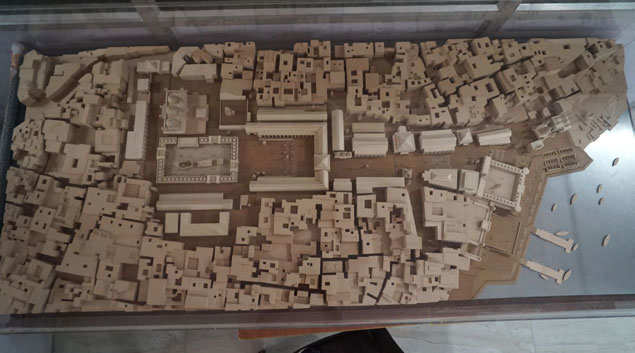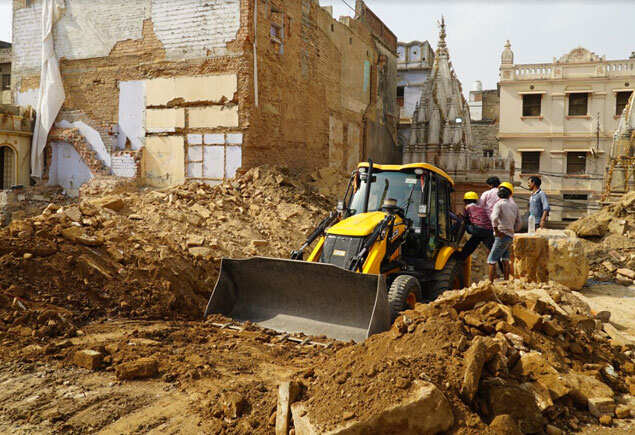
VARANASI: Around 10 pm on October 25, 2018, Eijaz Mohammad Islahi had returned home from the Gyanvapi Masjid when his cellphone rang. “Masjid ka chabootra toda ja raha hai (A platform of the mosque is being demolished),” said the voice on the other end.
There was no time to lose. The sound of footsteps echoed through the tapering lanes as Islahi rushed to cover the distance of a kilometre from his house in Nisherganj to reach the mosque, adjacent to Kashi Vishwanath temple, where a crowd running into hundreds, most of them members of the Muslim community, had gathered.

The chabootra at Gate number 4 of the Kashi Vishwanath temple-Gyanvapi mosque complex, a property of the Sunni Central Waqf Board, was being demolished by the administration as part of the Kashi Vishwanath corridor project.
Islahi, who has been the munsarim (caretaker) of the 17th century mosque for the past 30 years, said, “As a visibly angry mob paced by, the demolition was halted and the district administration had to rebuild the platform. It was done in the dark of the night and all of us kept guard of the area till dawn.”
But if there has been resistance, there is also anxiety. “Gyanvapi mosque could meet the same fate as Babri,” said S M Yaseen, joint secretary of the Anjuman Intezamiya Masajid (AIM), Varanasi, an administrative body of the Gyanvapi mosque.
“I remember the chant ‘Ayodhya to ek jhanki hai, Kashi, Mathura abhi baaki hai (Ayodhya was just a glimpse, Kashi and Mathura now remain)’ which became popular among karsewaks after Babri Masjid in Ayodhya was demolished in 1992,” added Yaseen.

The administration, though, says the fears are unfounded. District magistrate (DM) of Varanasi Surendra Singh told TOI: "The mosque is completely secure behind the barricades. There has been and will be no harm to it. The CCTV cameras and security personnel are assurance enough from the government for the mosque's safety. In December 2018, a team under the ADG (security) had also taken stock, so there will no compromise."
Singh also said that while the "chabootra" in question is not part of the barricaded mosque's campus, it is however in possession of the Sunni Waqf Board and is not a religious site. "When demolition was underway in October, we had thought of getting the roughly two feet high platform leveled. When objection was raised, we withdrew and got it rebuilt." Asked why the complaint was not converted into an FIR, Singh replied, "What sections of the IPC should we put into effect for the complaint when it is not about land encroachment? We have demarcated it for now."
But what is it about the project that has led some members of the minority community to draw parallels with the 1992 incident that triggered massive communal riots?
The answer lies in the labyrinth of narrow lanes — most of it now rubble — that leads to the temple and mosque and has come to characterize the city.
Yaseen puts it in perspective. “Until now, the shops, buildings and houses in the narrow lanes shielded the mosque. Now it stands exposed, surrounded by temples.”
Mufti Abdul Baatin Nomani, imam of the Gyanvapi mosque and secretary of AIM, agrees. "We don't object the corridor, but are concerned about the way it is being done. We fear for the mosque's safety. The lanes restricted movement and widening them could pave way for an Ayodhya-like mob attack."
“Between 1991 and 1992, before the Babri Masjid was demolished, the area surrounding the masjid was cleared by the then BJP government in UP led by Kalyan Singh for 'beautification' of Ayodhya,” said Yaseen.
This recall, in the backdrop of recent incidents in Varanasi, has left the community edgy.
Following the incident of October, in November 2018 the AIM approached the Supreme Court (SC) with a writ petition, expressing fear and asking for intervention. The body referred to an earlier SC order of 1995 which gave concerned parties, the temple and mosque committees, as also the government, option to approach court if needed.
The petition, however, was dismissed, saying it was based on “mere apprehension.”
Islahi spoke of another incident. “Recently, we noticed some people digging at the mosque’s property. They had a sack which had idols of a Hindu deity--the Nandi bull. When I asked them if they were trying to plant it inside the platform, the labourers left in haste. I complained to police but an FIR is yet to be registered.”
Some Hindus said they too were anxious. Mahant of the Sankat Mochan Mandir, and faculty at IIT (BHU), Prof Vishwambhar Nath Mishra told TOI, "No one has forgotten the right wing chant of 'Mathura and Kashi after Ayodhya'. But the social fabric of Varanasi is very strong."
Former mahant of the Kashi Vishwanath temple, Rajendra Tiwari, added: "After Ayodhya, Kashi is being turned into a political agenda. These are tough times."
There was no time to lose. The sound of footsteps echoed through the tapering lanes as Islahi rushed to cover the distance of a kilometre from his house in Nisherganj to reach the mosque, adjacent to Kashi Vishwanath temple, where a crowd running into hundreds, most of them members of the Muslim community, had gathered.

The chabootra at Gate number 4 of the Kashi Vishwanath temple-Gyanvapi mosque complex, a property of the Sunni Central Waqf Board, was being demolished by the administration as part of the Kashi Vishwanath corridor project.
Islahi, who has been the munsarim (caretaker) of the 17th century mosque for the past 30 years, said, “As a visibly angry mob paced by, the demolition was halted and the district administration had to rebuild the platform. It was done in the dark of the night and all of us kept guard of the area till dawn.”
But if there has been resistance, there is also anxiety. “Gyanvapi mosque could meet the same fate as Babri,” said S M Yaseen, joint secretary of the Anjuman Intezamiya Masajid (AIM), Varanasi, an administrative body of the Gyanvapi mosque.
“I remember the chant ‘Ayodhya to ek jhanki hai, Kashi, Mathura abhi baaki hai (Ayodhya was just a glimpse, Kashi and Mathura now remain)’ which became popular among karsewaks after Babri Masjid in Ayodhya was demolished in 1992,” added Yaseen.

The administration, though, says the fears are unfounded. District magistrate (DM) of Varanasi Surendra Singh told TOI: "The mosque is completely secure behind the barricades. There has been and will be no harm to it. The CCTV cameras and security personnel are assurance enough from the government for the mosque's safety. In December 2018, a team under the ADG (security) had also taken stock, so there will no compromise."
Singh also said that while the "chabootra" in question is not part of the barricaded mosque's campus, it is however in possession of the Sunni Waqf Board and is not a religious site. "When demolition was underway in October, we had thought of getting the roughly two feet high platform leveled. When objection was raised, we withdrew and got it rebuilt." Asked why the complaint was not converted into an FIR, Singh replied, "What sections of the IPC should we put into effect for the complaint when it is not about land encroachment? We have demarcated it for now."
But what is it about the project that has led some members of the minority community to draw parallels with the 1992 incident that triggered massive communal riots?
The answer lies in the labyrinth of narrow lanes — most of it now rubble — that leads to the temple and mosque and has come to characterize the city.
Yaseen puts it in perspective. “Until now, the shops, buildings and houses in the narrow lanes shielded the mosque. Now it stands exposed, surrounded by temples.”
Mufti Abdul Baatin Nomani, imam of the Gyanvapi mosque and secretary of AIM, agrees. "We don't object the corridor, but are concerned about the way it is being done. We fear for the mosque's safety. The lanes restricted movement and widening them could pave way for an Ayodhya-like mob attack."
“Between 1991 and 1992, before the Babri Masjid was demolished, the area surrounding the masjid was cleared by the then BJP government in UP led by Kalyan Singh for 'beautification' of Ayodhya,” said Yaseen.
This recall, in the backdrop of recent incidents in Varanasi, has left the community edgy.
Following the incident of October, in November 2018 the AIM approached the Supreme Court (SC) with a writ petition, expressing fear and asking for intervention. The body referred to an earlier SC order of 1995 which gave concerned parties, the temple and mosque committees, as also the government, option to approach court if needed.
The petition, however, was dismissed, saying it was based on “mere apprehension.”
Islahi spoke of another incident. “Recently, we noticed some people digging at the mosque’s property. They had a sack which had idols of a Hindu deity--the Nandi bull. When I asked them if they were trying to plant it inside the platform, the labourers left in haste. I complained to police but an FIR is yet to be registered.”
Some Hindus said they too were anxious. Mahant of the Sankat Mochan Mandir, and faculty at IIT (BHU), Prof Vishwambhar Nath Mishra told TOI, "No one has forgotten the right wing chant of 'Mathura and Kashi after Ayodhya'. But the social fabric of Varanasi is very strong."
Former mahant of the Kashi Vishwanath temple, Rajendra Tiwari, added: "After Ayodhya, Kashi is being turned into a political agenda. These are tough times."
Download The Times of India News App for Latest Elections News.
#ElectionsWithTimes
more from times of india news
Get the app











